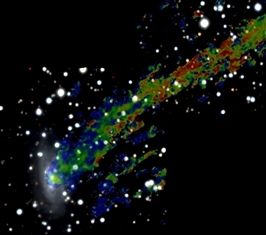10 November 2014
Scientists have observed in precise detail the stripping of gas from a distant galaxy as they seek to understand what shuts down star formation in galaxy clusters.
Using the European Southern Observatory’s MUSE instrument, the Durham University-led research team captured images of the spiral galaxy – known as ESO137−001 – which lies 200 million light years from Earth.
They found that the galaxy was being stripped of the interstellar gas it uses to form stars through a process called ram-pressure as it travelled through a galaxy cluster.
Ram-pressure happens when an object moves at high speed through an ambient medium – like a person feeling the air pass by them as they run.
The researchers believe the effect of ram-pressure in removing interstellar gas from galaxies could be the reason behind star formation coming to a halt in galaxy clusters.
They were able to rule out the effect of gravity in stripping the galaxy of its gas as observations of stars within the galaxy were normal. If gravity was having an effect, the researchers would have expected to see disruption within the galaxy.
The research, published today (Monday, November 10, 2014) in Monthly Notices of the Royal Astronomical Society, is funded by the Science and Technology Facilities Council (STFC).
Lead author Dr Michele Fumagalli, in the Centre for Extragalactic Astronomy and the Institute for Computational Cosmology, at Durham University, said: “Within galaxy clusters there are passive galaxies, hanging there, not forming stars because they don’t have a lot of the gas needed to form stars inside them.
“The puzzle we are trying to solve is how do star forming galaxies evolve into these passive galaxies within clusters?
“Our observations are catching a galaxy right when it is switching from star forming to passive, allowing us to learn how this happens.
“We believe the stripping of gas from the galaxy, caused by the ram-pressure, is halting the galaxy’s star formation.”
MUSE is an instrument of the European Southern Observatory’s Very-Large Telescope based in northern Chile.
It is the first large integral field spectrograph ever built at an eight metre telescope and allows researchers to take a picture of the sky, providing a spectrum – or band of colours - for each pixel in the frame.
Co-author Professor Richard Bower, in the Centre for Extragalactic Astronomy and the Institute for Computational Cosmology, at Durham University, said: “Thanks to these spectra, not only can we see the stripped gas, but we can study how the gas moves and what makes it move.
“Previous studies collected no more than 50 spectra for this galaxy, but MUSE allows us to collect about 90,000 spectra every time we look at an object giving us greater detail so we can understand much more about how the galaxy is evolving.”













